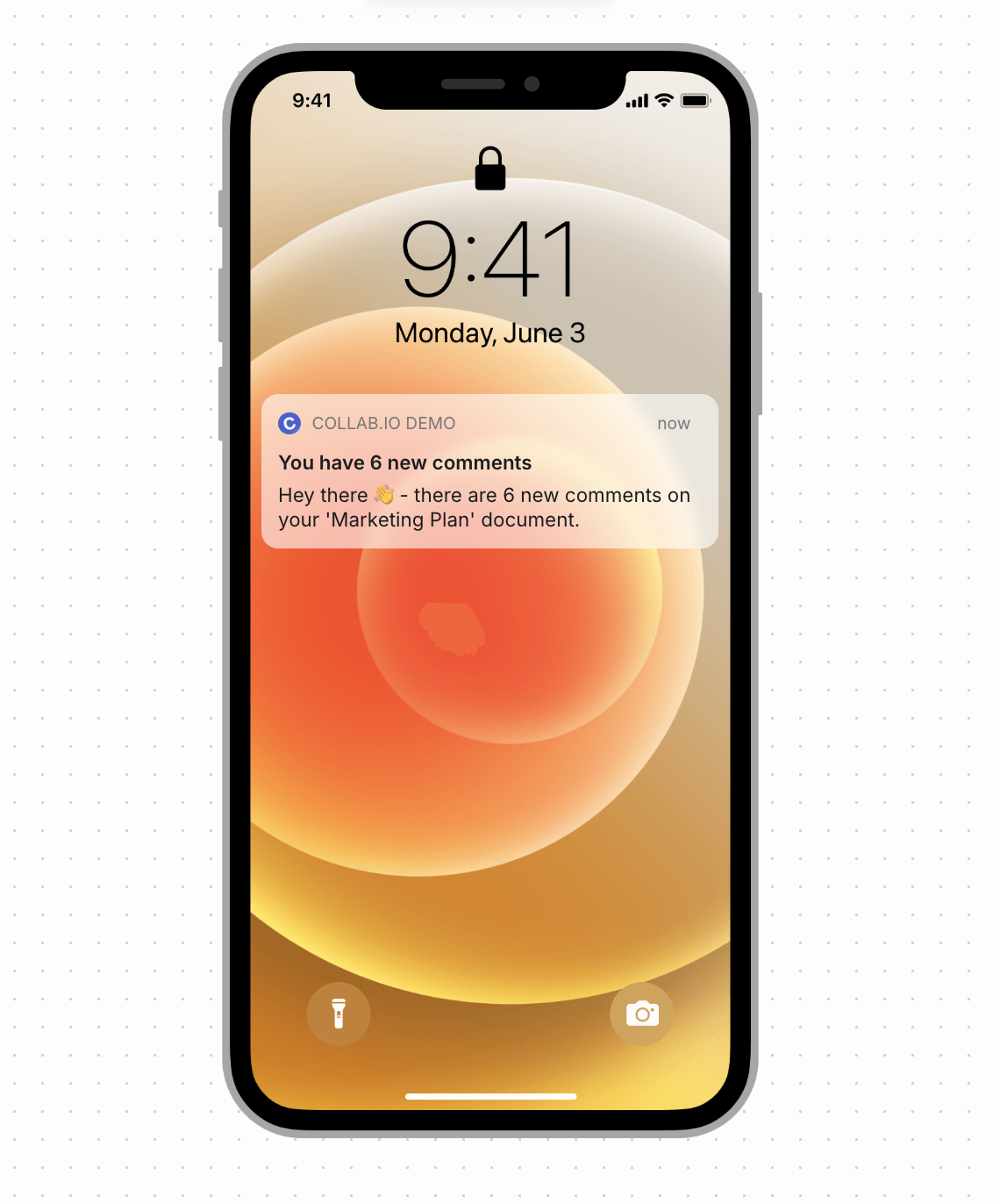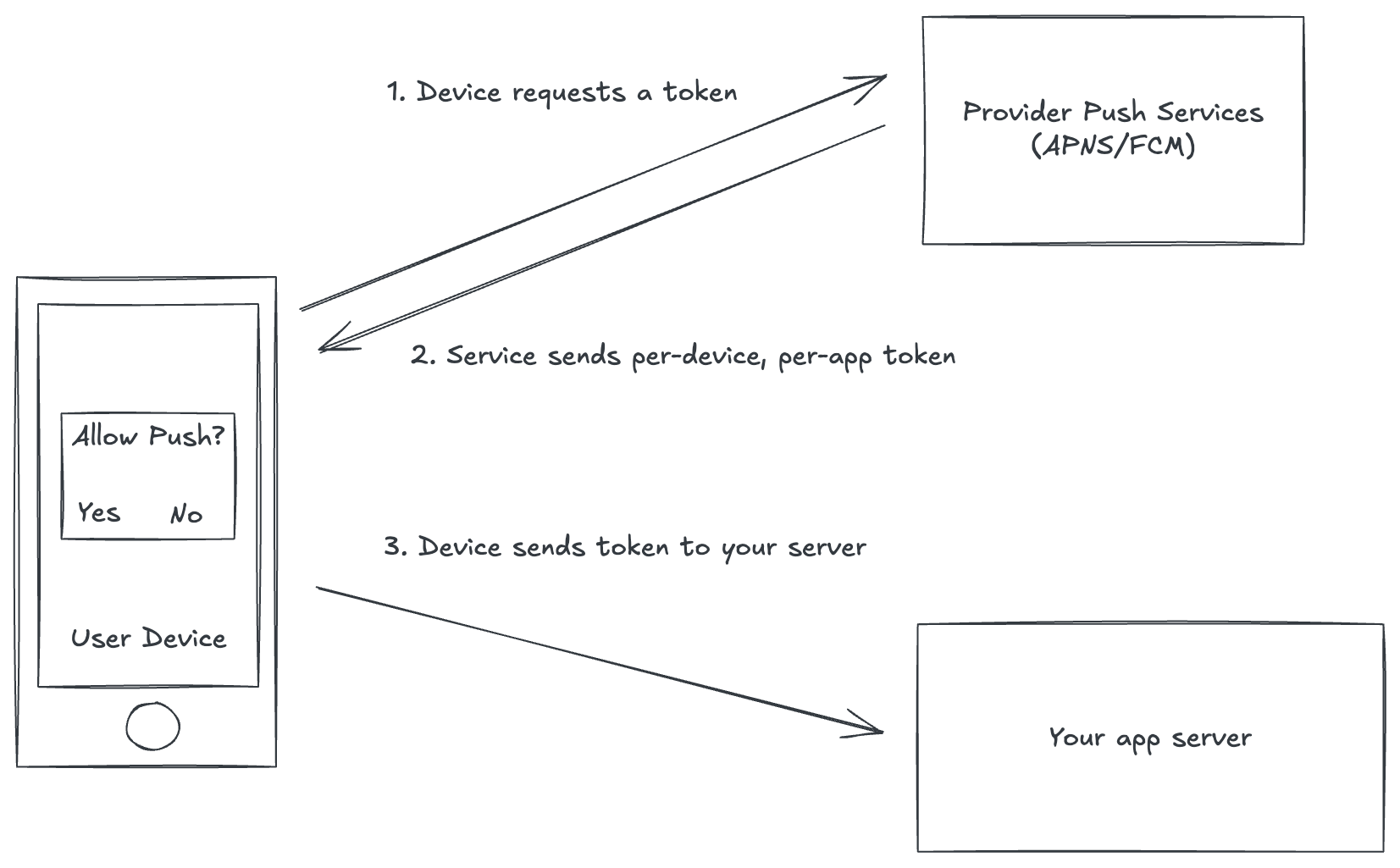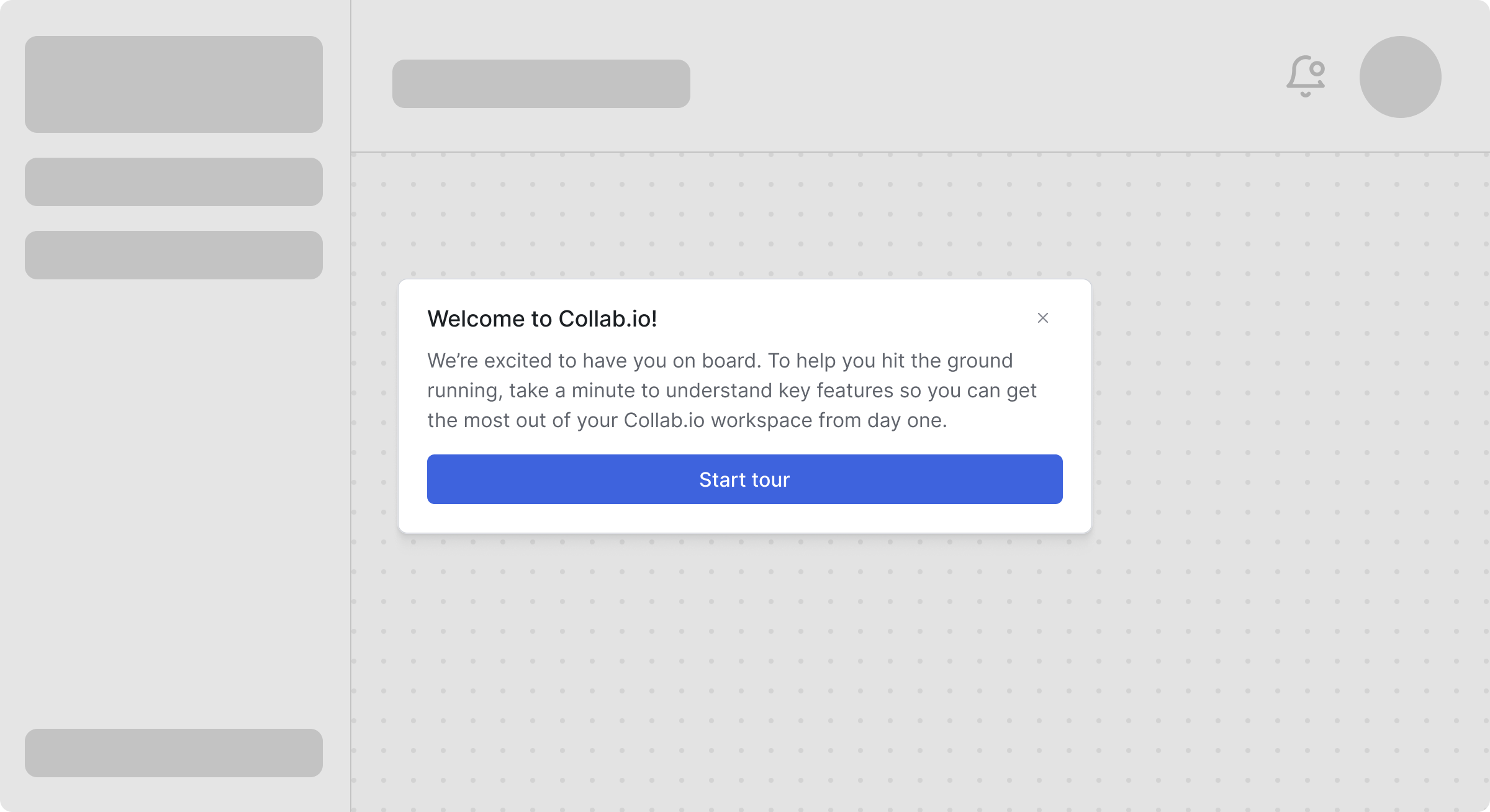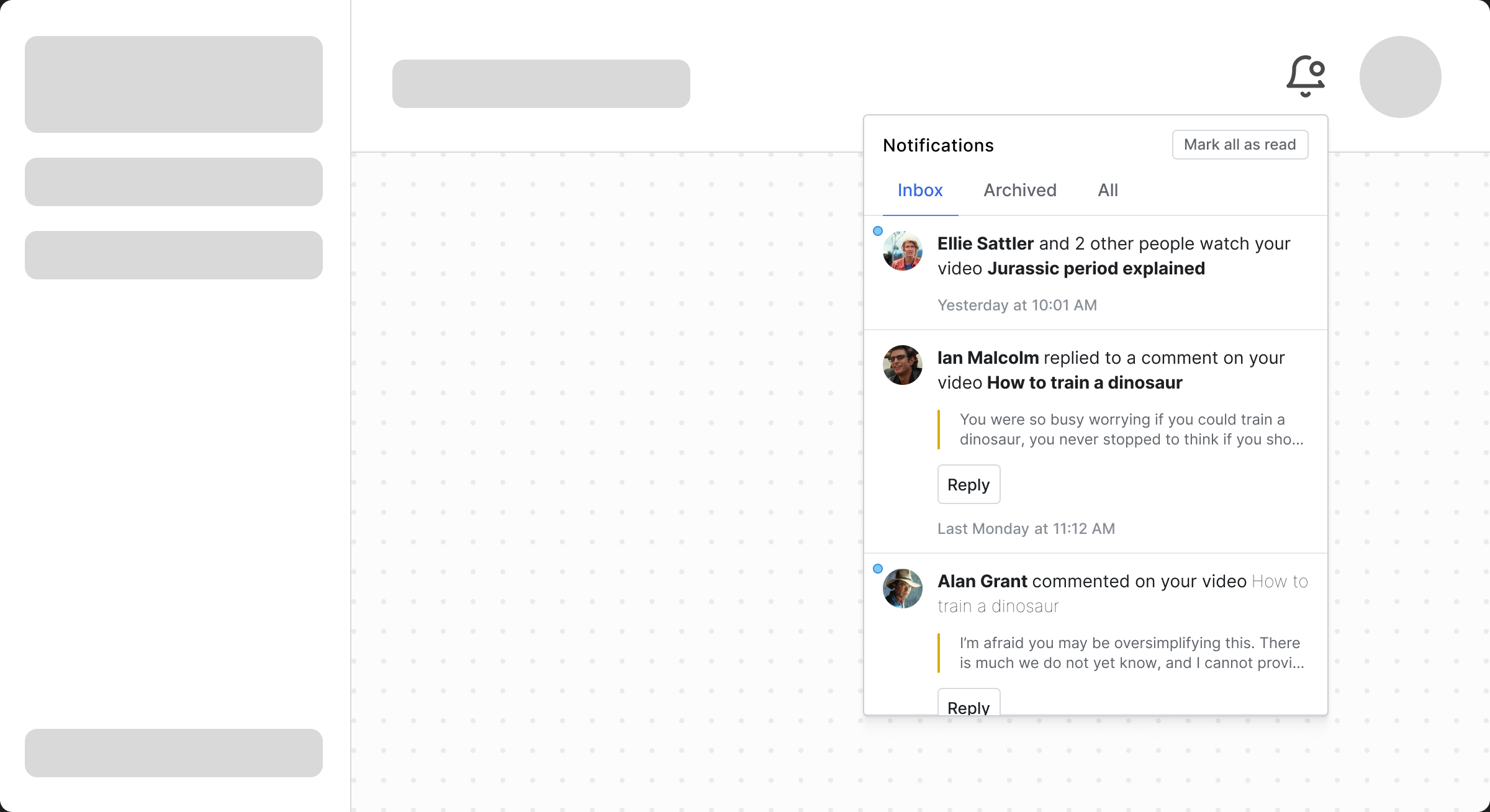Push notifications and in-app messaging are two of the most powerful channels for communicating with users, but they serve fundamentally different purposes. Understanding when to use each, and more importantly how to use them together, can transform your product's communication strategy.
Get it right, and you'll drive engagement and retention. Get it wrong, and you'll train users to ignore your messages or, worse, opt-out of notifications entirely.
What are push notifications?
Push notifications are messages delivered directly to users' devices even when your app isn't actively open. Think of that buzz on your lock screen telling you someone commented on your post, or the reminder that your food delivery is arriving soon.

An iOS push notification preview rendered in Knock's push template editor
These notifications operate through platform-specific services. On iOS, that's Apple Push Notification Service (APNs). On Android, it's Firebase Cloud Messaging (FCM). Your server sends a message to these services, which then route it to the user's device based on a unique device token.
The process works like this: when users first install your app, they're prompted to allow notifications. Once they grant permission, the device communicates with APNs or FCM to generate a unique token for that specific app installation on that specific device. Your app sends this token to your server, which stores it for future use.

A diagram of how push notifications permissions are requested
Later, when you want to notify that user, your server sends the message and token to the appropriate notification service, which delivers it to their device.

A diagram of how push notifications are sent
Push notifications have a few defining characteristics:
- They reach users outside your app, bringing them back when something important happens.
- They require explicit user permission and can be disabled at the device level.
- They're platform-dependent, with different implementations for iOS, Android, and web.
For a deeper dive into how push notifications work, check out our introduction to push notifications.
What is in-app messaging?
In-app messaging takes a completely different approach. These are messages delivered within your application's UI while someone is actively using it. Instead of competing for attention on a crowded lock screen, in-app messages appear exactly where users need them, with all the context of what they're currently doing.

An example welcome screen modal in Collab.io
When a user comments on a post, triggers a workflow, or hits a usage limit, your backend detects this event and determines whether to notify them. If so, it stores the message and uses real-time infrastructure (typically WebSocket connections) to push it immediately to any connected clients. Your UI components then render the notification in the appropriate format, such as a toast, a banner, a modal, or an item in their notification feed.

An example interactive feed update in Collab.io
The defining characteristics of in-app messaging are almost the opposite of push:
- They only reach users who are already active in your product.
- They don't require special permissions.
- You have complete control over design, placement, and behavior.
For more on how in-app messaging fits into your product, see our introduction to in-app messaging.
Key differences at a glance
| Push notifications | In-app messaging | |
|---|---|---|
| User state | Works when app is closed | Only for active users |
| Permission | Requires explicit opt-in | No permission needed |
| Design control | Platform-limited (APNs/FCM constraints) | Complete customization |
| Primary goal | Re-engagement & return | Guide & inform during session |
| Format options | Standard notification format | Feeds, banners, modals, toasts, tooltips, cards |
| Delivery channel | Through OS notification system | Within your app UI |
| Message persistence | Temporary (can be dismissed from lock screen) | Can persist in notification feeds |
| Best for | Time-sensitive alerts, reminders, re-engagement | Onboarding, feature discovery, contextual guidance |
When to use push notifications
Push notifications excel when you need to reach users who aren't currently in your app. They're your bridge to users between sessions, pulling them back when something requires their attention.

An example 'Comment' activity push notification
-
Activity that happens while users are away. Common use cases include someone commenting on their post, their document being approved, and their build finishing. These events happen asynchronously, and push notifications let users stay informed without constantly checking your app.
-
Time-sensitive alerts. Common use cases include when a payment fails, when there's suspicious login activity, or when a critical system issue occurs. Push notifications ensure users see the message immediately, even if they haven't opened your app in days.
-
Scheduled reminders and deadlines. A meeting starting in 5 minutes. A task due today. A subscription about to renew. These time-based triggers help users stay on track with their commitments.
-
Re-engagement campaigns for dormant users. If someone hasn't logged in for a week, a relevant, well-timed push notification can provide a compelling reason to return.
-
Cross-session workflows. In e-commerce, users need to know when their order ships, even if they're not actively shopping. In collaboration tools, users want alerts about changes to shared documents, whether they're working or not.
Consider these examples:
- E-commerce: "Your order has shipped! Track it here" or "The shoes you wanted are back in stock"
- SaaS: "Your deployment failed—click to see logs" or "3 approvals needed for pending documents"
- Social: "You have 3 new messages from your team"
- Productivity: "Daily standup starts in 5 minutes"
The pattern is clear: push notifications work when timing matters more than context, when users need to return to your app to take action, and when the value of the interruption outweighs the cost.
To understand the technical foundations of building push notification systems, explore our guide on core components of push notification systems.
When to use in-app messaging
In-app messaging excels when users are already engaged with your product and need guidance, confirmation, or non-urgent updates that complement their current workflow.

An example transactional update in-app message
-
User onboarding and feature discovery. When a new user first logs in, a welcome modal can set expectations and outline next steps. As they explore, tooltips can highlight features at the moment they become relevant. Cards can suggest advanced capabilities after users master the basics. The key is progressive disclosure: showing information exactly when users need it, not overwhelming them upfront.
-
Contextual tips at the moment of need. After someone completes a task, a toast might suggest a keyboard shortcut to work faster next time. When they open a new feature, a tooltip explains what it does. This just-in-time education is far more effective than lengthy tutorials.
-
Non-urgent transactional updates. Comments on posts, mentions in documents, order confirmations, and payment receipts are all important enough to note but don't require immediate action. Users can check their feed when convenient, knowing nothing will slip through the cracks.
-
Feature announcements to active users. When you ship something new, a card on the dashboard or a banner at the top of the screen reaches active users without interrupting those who aren't currently using your product. Save the push notification for major releases.
-
Upgrade prompts at natural decision points. When users hit their plan limit, an in-app modal explaining their options is helpful. When they're actively using a premium feature, a card suggesting an upgrade is contextually relevant.
-
System status updates. Common use cases include scheduled maintenance, a temporary slowdown in our API, or a new region being available. These announcements keep users informed without pulling them away from their work.
Different formats serve different purposes:
- Notification feeds: Best for comments, mentions, order updates, and anything users might reference later.
- Banners: Perfect for system-wide announcements, maintenance windows, and important but non-blocking information.
- Modals: Reserve for critical issues requiring immediate attention, like session timeouts or destructive action confirmations.
- Toasts: Ideal for quick confirmations ("Settings saved"), success messages, and brief updates.
- Tooltips: Great for onboarding, feature tips, and contextual help that feels native to your UI.
- Cards: Work well for feature highlights, promotional content, and embedded suggestions.
For practical guidance on making these decisions, read our best practices for in-app messaging.
Best practices for both channels
Regardless of channel, some principles apply universally to effective notification strategies.
Start with user preferences
Let users control their experience. Every notification system should offer global toggles, category-specific settings (transactional vs. promotional), and channel preferences (push, email, in-app) to prevent overload. And when users disable a notification type or dismiss a message repeatedly, honor that choice permanently.
You should also make smart choices on your end, like respecting quiet hours based on user timezones. Sending a "good morning" notification at 3 AM destroys trust instantly. Overall, default to conservative settings – it's easier to let users opt into more notifications than to recover trust after annoying them.
Write clear, actionable copy
Users spend maybe two seconds deciding whether to engage with a notification, so make every word count and front-load the critical information—the first few words determine whether users keep reading.
Additionally, be specific about what happened. Instead of "You have a notification" or "Update available," write "Sarah commented on your Q3 report" or "Your build #284 finished successfully."
Include clear next steps. "Your payment failed" is stressful and vague. "Your payment failed—update your card to restore service" tells users exactly what to do. Every notification should answer three questions:
- What happened?
- Why does it matter?
- What should I do about it?
Finally, keep your tone and voice consistent with your product. If you call them "projects," don't switch to "workspaces" in notifications. Use active voice for clarity: "12 people viewed your report" beats "Your report was viewed by 12 people."
Measure and optimize
Track the metrics that matter, like delivery rates, open rates, click-through rates, and dismissal rates. Then, try to connect notification interactions to downstream behaviors. Do users who see onboarding tips complete setup faster? Do upgrade prompts actually drive conversions?
Also, make sure to watch for negative signals. High dismissal rates suggest irrelevant or poorly timed messages. Support tickets mentioning "too many notifications" or "annoying pop-ups" should trigger immediate review, and unsubscribe spikes indicate you've crossed the line from helpful to intrusive.
From there, you can experiment with messaging, timing, and formats and let data guide your decisions. You don’t know what works better until you test it.
Channel-specific considerations
Push notifications have platform constraints you can't ignore. For example, you’ll need to keep payloads under 4KB. When permissions are denied, you’ll want to fall back to email or in-app messages instead. And if you find yourself sending many similar notifications within short periods of time, you’ll want to consider implementing smart batching to send efficient digests instead..
In-app messages require careful timing and format selection. Try to match the format to the level of urgency: modals for critical issues, banners for important announcements, toasts for confirmations, feeds for everything else. You should also consider how and where your messaging should be shown, like saving feature announcements for the dashboard page instead of a task-specific page that might interrupt a workflow. With throttling and ordering, you can better coordinate multiple in-app messages to avoid redundancy.
Using push and in-app together
The most effective notification strategies use both channels strategically, letting each play to its strengths.
Start with in-app messaging for active users, escalating to push if action isn't taken. When someone receives a message, show it in their notification feed first. If they don't see it within an hour, send a push notification. This respects users who are already engaged while ensuring important updates don't go unnoticed.
Use push to bring users back, then in-app to guide them. A push notification saying "Your document was approved" gets users into your app. Once there, an in-app message can prompt the next action: "Ready to publish? Here's how."
Track cross-channel engagement to optimize your strategy. If users consistently open push notifications but ignore in-app banners, you may need to adjust your approach to in-app. Maybe the timing is off, or the wrong messages are going to the wrong channels, or your user targeting could be improved.
Here are some examples of effective multi-channel workflows:
-
Comment notification: Batch comments on a particular resource and add it to the in-app feed immediately. If they don't read the in-app message within an hour, send a push notification and an email including details from all the comments. This graduated approach maximizes engagement while respecting users who are already active. You can reference this Knock workflow template for ‘Comments’ as an example.
-
Mention notifications: Since mentions are typically more specific and urgent than comments, you can immediately send notifications to multiple channels, like in-app, push, and email. In your messaging it’s important to give the user context around the mention, like what was said and by whom, as well as a clear link back into your app to address the mention and continue the conversation. You can reference this Knock workflow template for ‘Mentions’ as an example.
-
Onboarding flow: Create helpful modals or cards that are shown to new users before they take any dashboard actions. If they don't complete certain steps within two days, send a push notification highlighting what they're missing. Follow up with an email containing resources and links to documentation. This multi-channel approach accommodates different engagement patterns.
The key is coordination. Messages should feel like a coherent conversation across channels, not disconnected spam from different systems.
Implementation considerations
Building notification systems from scratch, whether push or in-app, involves significant technical complexity, and making them work together in the ways we’ve described only adds to this complexity. Understanding what's involved can help you decide whether to build or buy.
Push notifications: what's involved
Push notifications require managing device tokens across iOS and Android, authenticating with APNs and FCM, and building cross-platform payload structures that handle each provider's requirements differently. As you scale, you'll need message queues for reliable delivery, rate limiting to respect provider constraints, and comprehensive monitoring to track delivery rates and failed tokens.
Security and preference management add another layer. Device tokens must be encrypted, credentials need secure storage, and you need a robust system for handling user preferences—global toggles, category settings, quiet hours, and device-level controls that all must be checked before every send.
For technical details, see technical implementation of push notifications and building a preference system.
In-app messaging: what's involved
In-app messaging centers on real-time delivery infrastructure, typically WebSocket connections that maintain persistent communication between clients and servers. You need connection management that handles authentication, graceful reconnection, and coordination across multiple browser tabs.
Beyond delivery, you need event orchestration to determine which messages to send and when, persistent storage so messages sync across devices, and security measures to ensure users only see their own notifications. Your frontend must establish connections, handle reconnection, fetch and cache data, render different message formats, and sync state changes back to the server.
For comprehensive technical guidance, explore how to build an in-app messaging system.
Build vs buy: choosing your approach
The most critical decision is whether to build your notification infrastructure or use an existing platform.
When building might make sense
Some organizations have specific needs that justify custom development: strict regulatory compliance (HIPAA, GDPR with specific data residency), extreme scale where per-notification pricing becomes prohibitive, or highly unique product requirements that existing platforms can't accommodate.
But you should be realistic about the investment. You're not just building message delivery. You need token management, provider integration, preference systems, real-time infrastructure, state synchronization, analytics, monitoring, security, and ongoing maintenance. That's months of engineering time that could be better spent on your core product.
Why platforms often provide more value
Modern notification platforms offer comprehensive infrastructure that would take significant time to build, wrapped in developer-friendly APIs that get you to production in days instead of months.
Key advantages include multi-channel orchestration (push, email, SMS, in-app, and chat) with intelligent fallbacks and deduplication, advanced workflow capabilities like batching and timezone-aware scheduling, enterprise-grade reliability with 99.9% uptime SLAs, real-time analytics and A/B testing tools, and team collaboration features that let non-technical team members update messaging without code deployments.
Perhaps most importantly, platforms let your engineering team focus on building your product instead of maintaining notification infrastructure.
For detailed guidance on evaluation criteria, see delivering push notifications and how to choose an in-app messaging solution.
Orchestrate your in-app and push notifications with Knock
Push notifications and in-app messaging serve different but complementary purposes in your communication strategy. Push excels at re-engagement, bringing users back to your product when something important happens. In-app messaging shines at guidance, helping active users understand and use your product effectively.
Success doesn't come from choosing one over the other. It comes from understanding when to use each channel, implementing them thoughtfully, and orchestrating them into a cohesive user experience. Users don't care which channel you use. They care about receiving relevant information at the right time without feeling overwhelmed.
The technical complexity of building and maintaining these systems is substantial, which is why many teams choose modern notification platforms that handle the infrastructure while letting them focus on their core product.
Knock provides unified infrastructure for push notifications and in-app messaging, as well as email, SMS, and chat. With flexible APIs, powerful workflows, and enterprise-ready reliability, you can deliver the notification experience your users expect without months of custom development.
Start building with Knock's free tier or talk to our team about your specific needs.